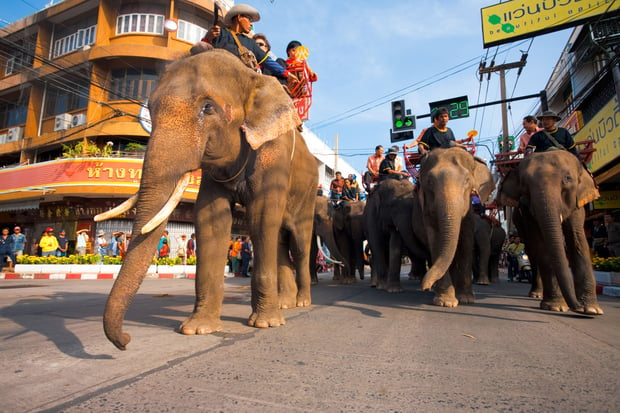Traveling to Southeast Asia is exciting and exotic. It conjures up images of bustling markets, thriving jungles and of course, their famous local wildlife, like elephants and tigers.
These creatures are facing a critical time, as both the Thai Elephant and the Indochina Tiger are currently recognized as endangered species. Learning the correct way to interact with them will not only save their existence, but also offer you a deeper understanding of the environment, culture and history in the region. This article is meant to show you the difference between sustainable wildlife operations and the dangers of mistreating these majestic animals.
Sustainability has been a significantly growing concern for tourism in Asia, as well as around the world. This is especially true when it comes to wildlife experiences throughout Thailand, Laos, Myanmar and many more Southeast Asian countries, such as Vietnam, Indonesia and Cambodia
Below, you will find our recommendation for things To Do and things Not To Do:

To Do:
Conservation
When choosing an elephant experience, make sure you find one that focuses on conservation, rather than only tourism. Promoting elephant conservation is an ideal way to help strengthen their population and offers a balanced approach to interacting with these creatures.
Rehabilitation
Elephants are strong animals and were used extensively in the logging industry, as the vehicles to transport heavy logs. A lot of elephants in modern conservation camps have been rescued and rehabilitated from their days in logging camps or in circuses. Elephants are extremely intelligent and giving them a good home to rehabilitate is paramount.
Education
As a traveler, we are constantly learning new things. Sustainable elephant camps focus on education and teach us how to become responsible Mahouts (elephant guides). Participating in a sustainable conservation initiative will teach you all about the life of an elephant, from their history, significance in culture, diet, habitat and much more. This type of experience is far more enriching than just riding through the jungle!

Not To Do:
Riding Elephants with a Saddle (Howdah)
Although some elephant conservation camps allow guests to ride on elephants, you should note that they do not use heavy saddles or massive lumbering seat arrangements strapped to the backs of the elephants. Avoid any operation that uses Howdahs, which are large crate like saddle seats, where guests sit. With these contraptions, the trainer sits on the elephant's neck with a bull hook to make them obey, as pictured above. Howdahs are known to leave lasting physical damages on the backs of elephants and are usually overloaded.
Elephant camps, such as Patara in Northern Thailand, allow for riding as well, however the guests get to ride bareback, with no physical damage to the elephant. With only one rider per elephant, they do not have any weight issues and the elephants are well treated for.
Chains around their legs
If you see an elephant activity where the elephants have chains around their legs, this is not a good sign. This indicates that rather than being rehabilitated, they are still in captivity and most likely mistreated.
That being said, chains are also sometimes necessary, even for responsible elephant camps. For example, at Myanmar's Green Hill Valley Elephant Camp, the elephants were once logging elephants used by the Myanmar government. They've been essentially saved by the organization and now have a much happier life being a part of sustainable tourism. Nevertheless, the camp still may need to use chains to help keep the elephants in a secure are of the camp. For example, during feeding time, to ensure the safety of the visitors, or in the case if an elephant is in heat, which can be very dangerous. It's not often you will see them in chains, but not all chains are created equal.
Cattle Prongs & Bull Hooks
These weapons are used to corral cattle as well as to mistreat elephants. They are cruel and can seriously injure the elephants physically and emotionally. Stay away from any operation using cattle prongs, bull hooks or any other form of hook or electric shock to train their animals.
Making Elephants Paint or do Tricks
Watching elephants paint a picture or perform tricks might be cute, but keep in mind the immense amount of time it takes to train these creatures to do these things. The training process is usually done with cattle prongs and cruel tactics. Even though it might seem harmless, the elephants are usually abused extensively to achieve these tricks.
Tiger Temples
The Indochina Tiger is a majestic king of the jungle and a greatly endangered species. Humans have contributed as a key element to their demise. The ever growing popularity of the "Tiger Temple", found outside of Bangkok and in Chiang Mai, Thailand are cruel institutions and we do not organize or recommend travelers to have anything to do with these experience. Although it sounds like a novel idea to sit with a tiger or wild cat in pictures, it is devastating to them. They are drugged, mistreated and malnourished. The Tiger Temple has been shut down, due to their mistreatment and any reproduction or representation of a similar service should be avoided at all costs.
In the end, a one on one experience with an elephant or any other wildlife is an experience of a lifetime. Keeping sustainability and rehabilitation in mind when choosing your wildlife activity is not only helping the animals, but also contributing to a more meaningful and one of a kind experience for you. Click below, to speak with one of our Travel Specialists on incorporating a unique elephant experience on your next trip to Southeast Asia.














